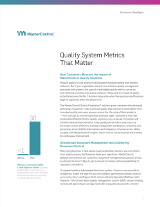
GxP Lifeline
Stop Throwing Away Valuable Data From Quality Management System Document Reviews and Start Using It

Quality and operations leaders in the life sciences industry are constantly challenged by a lack of visibility into how their quality systems are performing, and because unstructured data is a common problem and a main barrier to Quality 4.0 transitions, they are regularly putting out fires that could be avoided if they had access to the right information on a timely basis. There is a significant opportunity to address these challenges and gain the crucial insights companies are missing by leveraging the current work that quality management system document review teams are doing. The outcomes of their document reviews are producing key insights on how quality systems are performing, but standard processes lock this valuable data away, and what we consider quality gold is essentially thrown out.
Why and How is This Happening in Quality Management?
In most cases, quality document review teams do not have a standard place to record their findings. Without a uniform document management system, reviewers are forced to capture their outcomes in the form they prefer. In the rare case where they are provided a way to report their findings, they are often not all documented the same way.
For example, a quality control review team may have three batch record reviewers who all use a standard checklist, but one records their findings on a spreadsheet, another on a Word document, and the third in an email. In a more severe case, there could be a batch record reviewer and a complaints reviewer who do not have a standard checklist to follow, and one captures the outcomes of their reviews on an Excel sheet and the other on a paper-based report. Both scenarios make it impossible to use that information for further analysis, and what would lead to meaningful insights on compliance, risk levels, performance, and more is scattered on spreadsheets, documents, emails, checklists, and even paper-based records. Due to the unstructured nature of where these outcomes are stored, this prized information is siloed and never seen again.
The Opportunities Document Review Improvements Provide
If leaders want to transition to a proactive culture and make better data-driven decisions as fast as possible, the best place to start is by adjusting the day-to-day quality management system document review procedures to avoid having data collected in an unstructured way. A standard place to capture the outcomes of document reviews would allow teams to access valuable information and use it to further uncover gaps and areas for improvement in their management systems. This adds an opportunity for companies to begin or speed up the Quality 4.0 journey many are now exploring, but few have successfully achieved. Documenting information on a single system increases data accessibility which provides the pathway needed to adopt 4.0 technology such as artificial intelligence (AI) and real-time analytics. By applying newer technology to the outcomes of document reviews, teams can benefit from more meaningful insights, such as which systems are compliant or at risk, who needs more training, areas that are lagging in performance, processes that are consistently causing issues, and more on a real-time basis.
In our experience with clients, we witness a lot of work, time, and money spent on hiring external organizations to uncover and remediate quality system issues. For example, good documentation practices, long investigation closure times, and recurring issues with products or processes are common challenges we see across the board that could be proactively addressed with readily available data from quality management system document reviews. With the help of advanced analytics, companies could have information on how often and where documentation errors are occurring. With insights on true first-time-right metrics, they could approve investigations quickly and more consistently or even identify who needs more training when investigations are not completed properly. Additionally, insights on issues that are recurring across all shifts could be an indication that a batch record is difficult to understand and needs to be addressed.
If companies take advantage of the work their quality management system document review teams are producing, they could regularly have this information at their fingertips and quickly adjust so procedures are correctly executed the first time around, document reviews are performed more efficiently, and rework is no longer a common occurrence.
The Solution to Transforming Quality Management Is in Your Hands
Although the Quality 4.0 journey can seem daunting and overwhelming, it doesn't have to be. There is a simple solution for companies to start increasing visibility and transitioning to a more proactive culture by addressing their quality management system document review procedures. It's time for the industry to stop passing up the opportunities to improve operating performance their management systems are providing and start leveraging their current processes to extract meaningful data. It is feasible in the near term for companies to make more data-driven decisions, avoid costs of failures, and improve the overall quality of products for patients. Stay tuned for the continuation of this blog where we will cover methods and solutions that are currently available for companies to address this opportunity and reap the rewards as soon as possible.

